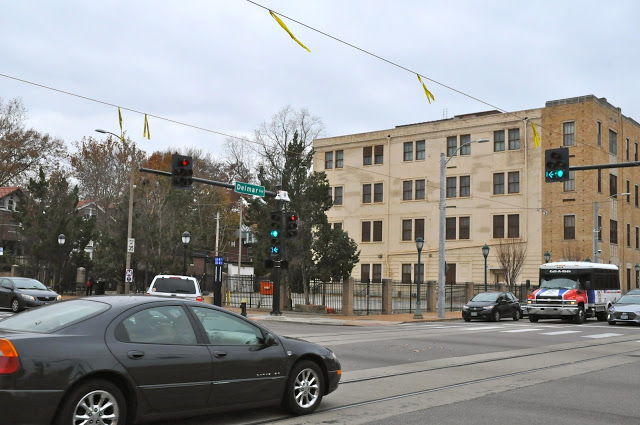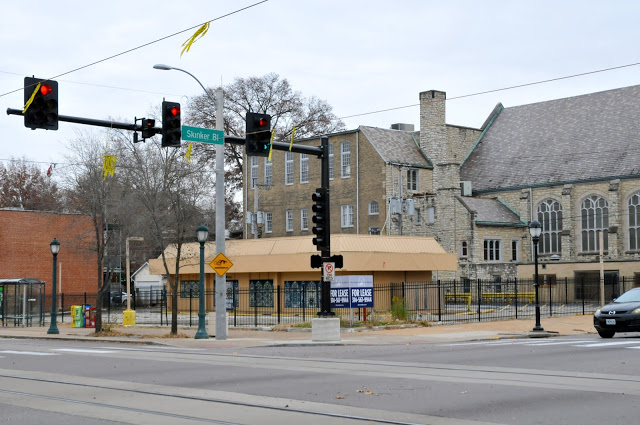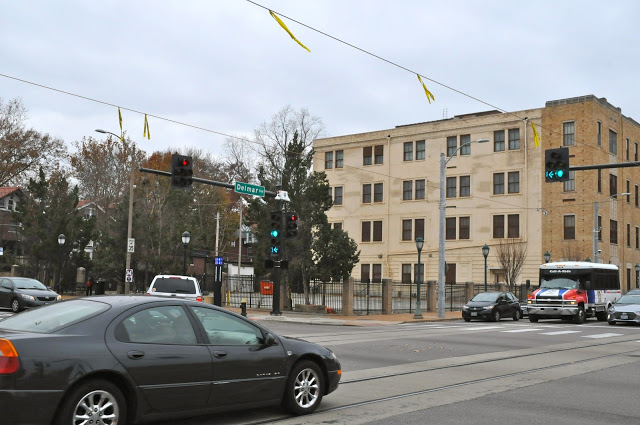I'm always trying to subjectively pinpoint the time period in St. Louis history when the majority of the suburban site plans that litter our city's current landscape came to be. I'm mostly referring to strip malls, fast food/drive through restaurants and contemporary churches...all surrounded by surface parking. When did this happen in the greatest numbers?
I recently stumbled upon an article from 1970 St. Louis which just might lend some credibility to the claim that the 1970's and 1980's was onset of destruction for the good city buildings switching to these auto-centric sites.
Most people I talk to who live in St. Louis don't want this type of development in their neighborhoods. The cities in the suburbs have the hammer lock on that style of planning and we should not try to compete with them. We have our strengths as a city that we must preserve and build upon and improve.
This is obvious to many who pay attention to St. Louis development and site planning, but the powers that be in St. Louis tend to favor development at any cost. From the lazy developers to the Preservation Review Board to the majority of the aldermen, suburban site plans are still ushered in with little to no push back or attempt at compromise. And sometimes they even get tax breaks further devaluing quality of life in St. Louis.
And this is not just the current regime, this has been going on for years ever since the auto-centric society took hold in the mid 20th Century.
Evidence of this is everywhere when you dig just a bit or do some exploring IRL, online or in publications. It's all there, just under the surface.
So, this blog is an attempt to shine a light on a grass roots effort to fight the junk food/suburban design powers that were taking hold in St. Louis...in 1970. The topic still feels current as we continue to see bad design enter our historic neighborhoods. Maybe not at the same pace as the 1970's and 80's, but it still happens.
Before we take a look at how a formerly urban intersection at Delmar and Skinker at the western edge of St. Louis evolved into what we now know of as a largely auto-centric intersection, you have to consider the city's history. What we now consider some of the nicest areas in St. Louis (including the Skinker/Debaliviere Neighborhood) were nearly allowed to fall to the ground in the vacuum created by the mass exodus of population from the city to the suburbs.
Here's an example of Skinker/Debaliviere alleys in 1970 vs. what now are occupied, well maintained buildings:
When the people left so did the businesses. Most of the retail closed in a matter of 10-20 years. Then sat the empty buildings. Then came the deferred maintenance and neglect. Then came vandalism and trespassing. Then came the call for demo. Then came the long vacant, empty lot. Then came the cheap land ripe for the lazy, suburban site plans for fast food, surface parking lots and strip malls with parking right out front.
Here's my proof of history repeating itself, this example from April, 1970.
I am a big fan of urbanstl.com. I learn a lot from that forum. Recently while reading about a project at the north west corner of Skinker and Delmar, I came across a posting by someone using the handle: "quincunx".
There was a picture that immediately caught me of the south west corner of Delmar and Skinker.
The Paper - April, 1970
If I'm not mistaken, the beauty on the left is the south west corner next to the AT&T building that is now a fenced in surface parking lot and has been for at least 40 years. Why in the hell was that allowed to be destroyed for surface parking at such a prominent intersection.
Here's what we have instead of a beautiful corner building:
I guess the St. Louis of the 1970's was just as short sighted as the current one.
The suburban fast food drive through on the right of that image caught my eye too. At first I thought it was the south east corner of Skinker and Delmar that was most recently a Church's Fried Chicken, but that isn't the case based on the buildings in the background.
I had to find out where that photo came from. After a quick post on the forum, I got the skinny. It was from the online archive of the Times of Skinker DeBaliviere. Thanks to the kind soul that took the time and effort to scan these publications in for all the St. Louis nerds out there who eat this stuff up.
And, thanks to "quincunx" over at urbanstl.com for tipping folks to this great resource.
The Jack in the Box article is revealing and timely in my neck of the woods. The suburban site planning that destroyed our urban fabric is still taking place. I'll be writing about one such case that could be going before the Preservation Review Board in the coming weeks that will seek to bring a bit of the burbs to a historic neighborhood on a major city street.
History tends to repeat itself, and when the city powers that be (developers, Preservation Review Boards, aldermen) usher in the lazy, auto-centric designs and don't stand up for the people, the well planned historic codes and the built environment, it'll continue to happen.
Here's the story on how one such story went down in 1970.
From the Times of Skinker DeBaliviere article, a Jack-In-The-Box was to be constructed at Delmar and Skinker. A group called "Stop Jack-in-the-Box" formed to fight Foodmaker, Inc. the company trying to bring the drive through fast food chain to a dense, urban neighborhood. Foodmaker, Inc was owned by Ralston-Purina.
“Citizens have objected to intrusion of a drive-in food operation in a residential neighborhood. They strongly oppose ‘ the attraction of transients, the noise, litter, and additional traffic at a busy intersection. They charge that the garish and unsightly construction would harm the entire area at a time when residents are struggling to maintain stability. Spokesmen for Foodmaker, Inc. have replied that the lots are zoned commercial and open to construction of a drive-in facility. They then further stated that they would be required by the city to provide an access lane along Skinker. They maintain that limited parking and seating space in their restaurants discourage patrons from congregating or causing disturbances.”
With the scent of NIMBYism and social issues aside, this fast food drive through is a 40-50 year decision. Think about that. A suburban site plan, if allowed, will sit and be a problem for a generation even after the business closes. This is not some flip decision.
We can't let our city be chipped away at like this. We have to take steps forward, not backward in rebuilding our city.
1970's St. Louisans tried to fight it. And they lost, one of the most prominent intersections at Delmar and Skinker has had a long-shuttered fast food restaurant, a surface parking and a gas station for a generation at three of its four corners. Money, lack of education on good site planning and the political fear of being anti-development usually holds sway in this city.
The "Stop the Jack-in-the-Box" group was organized, they hired a law firm to attempt a fight. This is not cheap, most citizen groups and neighborhood organizations can't afford this type of thing. They still lost.
“In the face of repeated objections, Foodmaker, Inc. has assured the community that the building at Skinker and Delmar would be of brick-and-shingle construction. Meanwhile the Washington University student group, “Stop Jack-in-the-Box,” has retained Courtney Goodman, Jr. as their legal counsel. They base their objections on the fact that the buildings now occupying the site are suitable to the neighborhood and house small businesses which draw on a local, walk-in trade. The students have expressed strong feelings that Jack-in-the-Box construction constitutes visual pollution of the local environment. ”
The city ushered in the plan and the money; you can bet it was hard for the city to buck Ralston Purina, so the aldermen folded.
“Events affecting the proposed construction of the Jack-in-the-Box at Skinker and Delmar have been occurring almost daily. Agents of the various concerned citizens groups appeared at and spoke to a meeting of the St. Louis Aldermanic Legislative Research Committee on February 2 The committee is considering legislature to set standards and limitations for the rapidly growing number of drive-in operations, including a specific proposal making operators of drive-in food operations legally responsible for litter from their establishment within a 300 yard radius of the site. ”
The citizens didn't quit, a group of residents and students picketed in front of Ralston Purina. They got time with the Ralston officials, who essentially blew them off.
Then Foodmakers, Inc sent their representative to he Skinker-Rosedale Neighborhood Association to try to sell the drive through. Four residents voted in favor and 61 voted against. The city still couldn't represent the residents...there was just too much money and corporate support from Ralston.
“The citizens proposed that Ralston Purina turn the building at Skinker and Delmar over to a non profit corporation which would encourage the present occupants to remain and seek additional small businesses that would cater to residents of the neighborhood.
Although Mr. O’Brien observed that the group seemed to have a “bias against anything other than businesses that are completely local,” he did nonetheless agree to meet again with the group for dinner and further discussion at the Chinese Restaurant.”
I think we both know how this story ended. And how it left it's suburban, auto-centric mark on a generation.
The good news, there are better uses being proposed at the site of the former Church's and gas station. But it took over 45 years to get to this point.
We really have to do better when it comes to defending the city's grid and built environment.
I'm drafting a story of this exact thing unfolding right in my backyard. Stay tuned.
Will history repeat itself?








